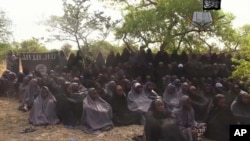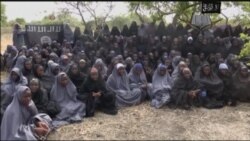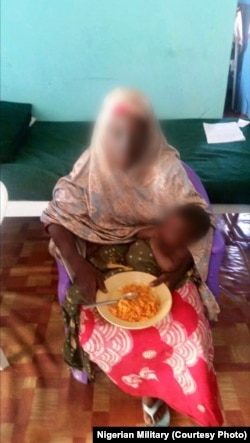Nigerian military officials are debriefing the first schoolgirl to be rescued since Boko Haram militants carried out an infamous mass kidnapping in northeast Nigeria more than two years ago, officials told VOA.
Amina Ali was among nearly 300 girls abducted when members of the Islamist militant group stormed the Government Secondary School in the town of Chibok in April 2014. Many escaped immediately after the kidnapping, but over 200 remain missing. Amina Ali was reunited with her mother in her home village Mbala, where the two had a joyful reunion Tuesday before they were taken to a military camp to be debriefed.
Exact details of her rescue remain unclear. Army spokesman Sani Usman said Nigerian soldiers rescued the girl in a village called Baale, near the town of Damboa. Usman told VOA's Peter Clottey that the army has been debriefing Amina Ali at a military base in Damboa. He said she was found with another individual when she was rescued. The man, suspected of being a Boko Haram militant, is being questioned at the same base, he said.
Watch video report from VOA's Zlatica Hoke:
He says Amina Ali is currently giving "lots of information" to military officials about the whereabouts of the other kidnapped girls.
"In line with keeping faith with the public by the time we complete our preliminary investigation, certainly we will let you know where they are and what happened to some of them. But, quite a number of things are coming out from here," he said.
Aboku Gaji, leader of a vigilante group in Chibok that was set up to defend against Boko Haram, took credit for the rescue. He said his men stumbled on the girl while laying an ambush outside a militant camp.
"As we lie ambush, they come on us," he told VOA.
He said the girl was found near the Sambisa forest, a militant stronghold where the schoolgirls were thought to have been taken after the kidnapping. Gaji also said the rescued girl had a baby with her.
"She told us that the other girls were still there in the Sambisa," Gaji said.
But six of the girls have died in captivity, Gaji said the girl told him. Usman will neither confirm nor deny that six of the abducted school girls have died.
He says the vigilante group credited with rescuing the kidnapped school girl is playing a key role in the fight against Boko Haram.
Hoping to rescue the other girls
The army recently launched a military offensive aimed at putting pressure on Boko Haram as well as rescuing unarmed civilians kidnapped by the militants.
"We have been able to rescue over 12,000 people, and I believe that we have more people that are being held hostage by the Boko Haram terrorists in some of these their hideouts… We have been working to also ensure that we rescue them, including the abducted Chibok school girls. And we are hopeful, definitely, wherever they are we will definitely rescue them," added Usman.
Col. Usman says the soldiers on the frontlines fighting Boko Haram are pleased with the progress of the recently launched operation crackdown in the Sambisa Forest. "I can tell you their morale is incredibly high and they are looking forward to rescuing all other abducted girls and flushing out the Boko Haram terrorists wherever they are," said Usman.
'Wonderful piece of news'
U.N. Humanitarian chief Stephen O'Brien welcomed news of the girl's rescue "Wonderful piece of news to have one of the Chibok girls rescued and being returned," he said. "There will of course be a deep need for us all to recognize that this girl, whose name I don't yet know, no doubt suffered terrible trauma and will need to be given space and the support, both short and long term.'
In its seven-year war to impose strict Islamic law in northern Nigeria, Boko Haram has massacred civilians, burnt down villages and carried out numerous kidnappings. Over 20,000 people have been killed, and more than two million displaced.
But the Chibok kidnapping remains the group's most infamous crime.
It sparked protests across Nigeria, as people took to the streets, imploring the government to "bring back our girls."
Shortly after the kidnapping, Boko Haram released a video showing the girls. Last month, CNN unearthed a video supposedly used in negotiations for the girls' release that featured 15 of the girls.
Despite numerous rumors and false alarms, there's been no physical sign of any of the girls, until Wednesday
Pogo Bitrus, chairman of the Chibok Elders Forum, said he was "elated" by news of the rescue.
"At least they are alive, they are being found and whatever situation and condition, that doesn't matter," Bitrus said. "The important thing is, they are alive and they are being found."
What is Boko Haram?
- Based in northeastern city of Maiduguri.
- Self-proclaimed leader is Abubakar Shekau.
- Began in 2002 as a non-violent Islamist splinter group.
- Launched an uprising in 2009, and since 2010 has killed nearly 20,000 people.
- Its insurgency has displaced nearly 2 million people and left nearly 1 million children with little or no access to an education.
- Amnesty International said about 2,000 children have been abducted by Boko Haram since 2014. Many are used as sex slaves, fighters and suicide bombers.
- Boko Haram translates to "Western education is sinful."
- In March 2015, Boko Haram affiliates itself with the Islamic State group.
VOA's Peter Clottey and Margaret Besheer contributed to this report








